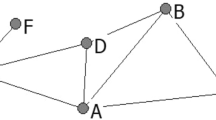Abstract
A feasibility study on the technology and market trends of organoids was conducted by analyzing information using published patent information and network analysis. It was found that the organoid market exhibits a scale-free network structure among complex networks, and that Japanese research is isolated and domestic-only. On the other hand, the largest research clusters were found to have research institutions with structural holes, indicating that collaboration with foreign research institutions with such holes is desirable to accelerate Japanese research. This suggests the effectiveness of an analytical method that combines patent analysis and network analysis for practitioners.
Access this chapter
Tax calculation will be finalised at checkout
Purchases are for personal use only
Similar content being viewed by others
References
Hutchinson, L., Kirk, R.: High drug attrition rates-where are we going wrong? Nat. Rev. Clin. Oncol. 8(4), 189–190 (2011)
Sato, T., et al.: Single Lgr5 stem cells build crypt-villus structures in vitro without a mesenchymal niche. Nature 459(7244), 262-U147 (2009)
Sato, T., et al.: Long-term expansion of epithelial organoids from human colon, adenoma, adenocarcinoma, and Barrett’s epithelium. Gastroenterology 141(5), 1762–1772 (2011)
Dekkers, J.F., et al.: Characterizing responses to CFTR-modulating drugs using rectal organoids derived from subjects with cystic fibrosis. Sci. Transl. Med. 8(344), 344–384 (2016)
Vlachogiannis, G., et al.: Patient-derived organoids model treatment response of metastatic gastrointestinal cancers. Science 359(6378), 920–931 (2018)
Burrell, R.A., McGranahan, N., Bartek, J., Swanton, C.: The causes and consequences of genetic heterogeneity in cancer evolution. Nature 501(7467), 338–345 (2013)
Chen, Z.Y., et al.: EGFR mutation heterogeneity and the mixed response to EGFR tyrosine kinase inhibitors of lung adenocarcinomas. Oncologist. 17, 978–985 (2012)
Mroz, E.A., Tward, A.D., Pickering, C.R., Myers, J.N., Ferris, R.L., Rocco, J.W.: High intratumor genetic heterogeneity is related to worse outcome in patients with head and neck squamous cell carcinoma. Cancer 119, 3034–3042 (2013)
Van de Wetering, M., et al.: Prospective derivation of a living organoid biobank of colorectal cancer patients. Cell 161(4), 933–945 (2015)
Roerink, S.F., et al.: Intra-tumour diversification in colorectal cancer at the single-cell level. Nature 556(7702), 457–463 (2018)
Brandenberg, N., et al.: High-throughput automated organoid culture via stem-cell aggregation in microcavity arrays. Nat. Biomed. Eng. 4(9), 863–876 (2020)
Decembrini, S., Hoehnel, S., Brandenberg, N., Arsenijevic, Y., Lutolf, M.P.: Hydrogel-based milliwell arrays for standardized and scalable retinal organoid cultures. Sci. Rep. 10, 10275 (2020)
Hosokawa, M., Arakaki, A., Takahashi, M., Mori, T., Takeyama, H., Matsunaga, T.: High-density microcavity array for cell detection: single-cell analysis of hematopoietic stem cells in peripheral blood mononuclear cells. Anal. Chem. 81(13), 5308–5313 (2009)
Osada, K., Hosokawa, M., Yoshino, T., Tanaka, T.: Monitoring of cellular behaviors by microcavity array-based single-cell patterning. Analyst. 139(2), 425–430 (2014)
Granovetter, M.S.: The strength of weak ties. Am. J. Sociol. 78(6), 1360–1380 (1973)
Nieman, U.J.: On the centrality in a directed graph. Soc. Sci. Res. 2(4), 371–378 (1973)
Boissevain, J.: Towards a sociology of social anthropology. Theory Soc. 1, 211–230 (1974)
Freeman, L.C.: A set of measures od centrality based on betweeness. Sociometry 40(1), 35–41 (1977)
Freeman, L.C.: Centrality in social networks conceptual clarification. Soc. Netw. 1, 215–239 (1978)
Coleman, J.S.: Social capital in the creation of human capital. Am. J. Sociol. 94, S95–S120 (1988)
Watts, D.J., Strogatz, S.H.: Collective dynamics of ‘Small-world’ networks. Nature 393, 440–442 (1998)
Burt, R.S.: Structural Holes: The Social Structure of Competition. Harvard University Press, Cambridge, Mass (1992)
Fleming, L., Mingo, S., Chen, D.: Collaborative brokerage, generative creativity, and creative success. Adm. Sci. Q. 52, 443–475 (2007)
Kishi, N.: Network characteristics and product development performance, p 218. MMRC Discussion paper (2008)
Konno, N.: Complex network Tokyo Japan Kindai Kagakusya (2010)
Biagini, F., Kauermann, G., Meyer-Brandis, T. (eds.): Network Science. Springer, Cham (2019). https://doi.org/10.1007/978-3-030-26814-5
Author information
Authors and Affiliations
Corresponding author
Editor information
Editors and Affiliations
Rights and permissions
Copyright information
© 2023 The Author(s), under exclusive license to Springer Nature Switzerland AG
About this paper
Cite this paper
Hayashida, H., Funashima, H. (2023). Social Network Analysis to Accelerate for R&D of New Material Development. In: Uden, L., Ting, IH. (eds) Knowledge Management in Organisations. KMO 2023. Communications in Computer and Information Science, vol 1825. Springer, Cham. https://doi.org/10.1007/978-3-031-34045-1_14
Download citation
DOI: https://doi.org/10.1007/978-3-031-34045-1_14
Published:
Publisher Name: Springer, Cham
Print ISBN: 978-3-031-34044-4
Online ISBN: 978-3-031-34045-1
eBook Packages: Computer ScienceComputer Science (R0)




